高中英语中有比较结构的怎么翻译
- 格式:doc
- 大小:9.12 KB
- 文档页数:2
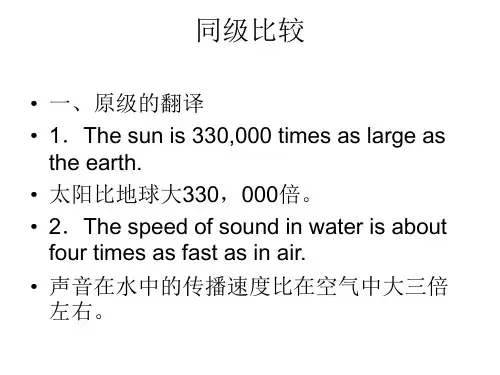
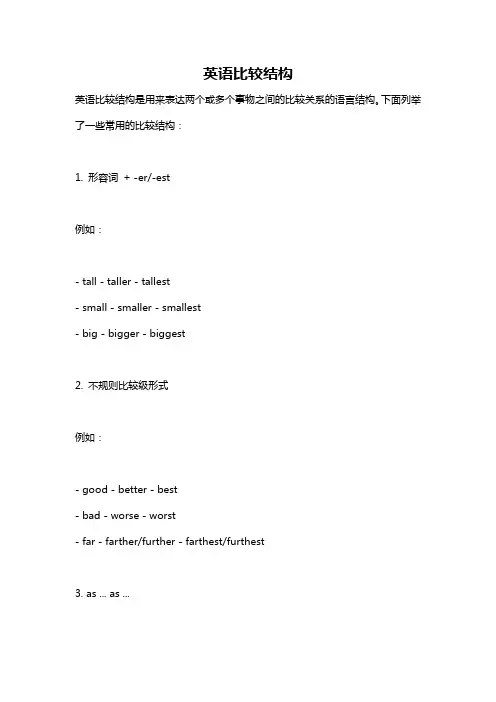
英语比较结构英语比较结构是用来表达两个或多个事物之间的比较关系的语言结构。
下面列举了一些常用的比较结构:1. 形容词+ -er/-est例如:- tall - taller - tallest- small - smaller - smallest- big - bigger - biggest2. 不规则比较级形式例如:- good - better - best- bad - worse - worst- far - farther/further - farthest/furthest3. as ... as ...例如:- You are as tall as your brother.- This car is as fast as that one.- That movie is as good as this one.4. more/less ... than ...例如:- She is more outgoing than her sister.- This book is less interesting than the other one.- The red shirt is more expensive than the blue one.5. the + 比较级 ... the + 比较级 ...例如:- The more you study, the better your grades will be.- The earlier you arrive, the better your chances of getting a good seat. - The less you talk, the more people will listen to you.6. 比较句型(比较...)例如:- He is taller than I am.- She is more intelligent than her brother. - The weather is colder than yesterday.。
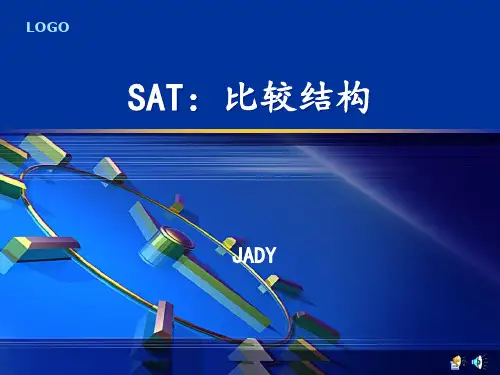
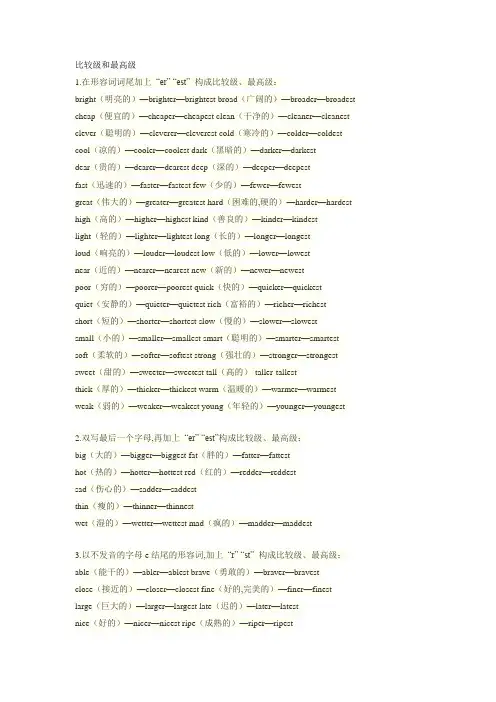
比较级和最高级1.在形容词词尾加上“er” “est” 构成比较级、最高级:bright(明亮的)—brighter—brightest broad(广阔的)—broader—broadest cheap(便宜的)—cheaper—cheapest clean(干净的)—cleaner—cleanest clever(聪明的)—cleverer—cleverest cold(寒冷的)—colder—coldest cool(凉的)—cooler—coolest dark(黑暗的)—darker—darkestdear(贵的)—dearer—dearest deep(深的)—deeper—deepestfast(迅速的)—faster—fastest few(少的)—fewer—fewestgreat(伟大的)—greater—greatest hard(困难的,硬的)—harder—hardest high(高的)—higher—highest kind(善良的)—kinder—kindestlight(轻的)—lighter—lightest long(长的)—longer—longestloud(响亮的)—louder—loudest low(低的)—lower—lowestnear(近的)—nearer—nearest new(新的)—newer—newestpoor(穷的)—poorer—poorest quick(快的)—quicker—quickestquiet(安静的)—quieter—quietest rich(富裕的)—richer—richestshort(短的)—shorter—shortest slow(慢的)—slower—slowestsmall(小的)—smaller—smallest smart(聪明的)—smarter—smartest soft(柔软的)—softer—softest strong(强壮的)—stronger—strongest sweet(甜的)—sweeter—sweetest tall(高的)-taller-tallestthick(厚的)—thicker—thickest warm(温暖的)—warmer—warmest weak(弱的)—weaker—weakest young(年轻的)—younger—youngest2.双写最后一个字母,再加上“er” “est”构成比较级、最高级:big(大的)—bigger—biggest fat(胖的)—fatter—fattesthot(热的)—hotter—hottest red(红的)—redder—reddestsad(伤心的)—sadder—saddestthin(瘦的)—thinner—thinnestwet(湿的)—wetter—wettest mad(疯的)—madder—maddest3.以不发音的字母e结尾的形容词,加上“r” “st” 构成比较级、最高级:able(能干的)—abler—ablest brave(勇敢的)—braver—bravestclose(接近的)—closer—closest fine(好的,完美的)—finer—finestlarge(巨大的)—larger—largest late(迟的)—later—latestnice(好的)—nicer—nicest ripe(成熟的)—riper—ripestrude(粗鲁的)—ruder—rudest safe(安全的)—safer—safeststrange(奇怪的)—stranger—strangest wide(宽广的)—wider—widestwise(睿智的,聪明的)—wiser—wisestwhite(白的)—whiter—whitest4.以字母y结尾的形容词,把y改为i,再加上“er”“est”构成比较级、最高级:busy(忙碌的)—busier—busiest dirty(脏的)—dirtier—dirtiestdry(干燥的)—drier—driest early(早的)—earlier—earliesteasy(容易的)—easier—easiest friendly(友好的)—friendlier—friendliest funny(好玩的)—funnier—funniest happy(开心的)—happier—happiest healthy(健康的)—healthier—healthiest heavy(重的)—heavier—heaviest hungry(饿的)—hungrier—hungriest lazy(懒惰的)—lazier—laziestlucky(幸运的)—luckier—luckiest naughty(调皮的)—naughtier—naughtiest noisy(嘈杂的)—noisier—noisiest pretty(美丽的)—prettier—prettiestsilly(傻的)—sillier—silliest spicy(辣的)—spicier—spiciestthirsty(渴的)—thirstier—thirstiest ugly(丑的)—uglier—ugliest5.双音节、多音节形容词,在单词前面加上“more” “most”构成比较级、最高级:afraid(害怕的)—more afraid—most afraidbeautiful(美丽的)—more beautiful—most beautifulcareful(仔细的)—more careful—most carefulcheerful(开心的)—more cheerful—most cheerfulcrowded(拥挤的)—more crowded—most crowdeddangerous(危险的)—more dangerous—most dangerousdelicious(美味的)—more delicious—most deliciousdifficult(困难的)—more difficult—most difficultexciting(令人兴奋的)—more exciting—most excitingexpensive(昂贵的)—more expensive—most expensivefamous(著名的)—more famous—most famousfrightened(受惊的)—more frightened—most frightenedfrightening(令人害怕的)—more frightening—most frighteninghard-working(勤奋的)—more hard-working—most hard-workinghelpful(有帮助的)—more helpful—most helpfulhonest(诚实的)—more honest—most honestimportant(重要的)—more important—most importantinteresting(有趣的)—more interesting—most interestingpolite(有礼貌的)—more polite—most politeterrible(可怕的)—more terrible—most terribletired(累的)—more tired—most tired6.不规则变化的形容词:bad(坏的)—worse—worstfar(远的)—farther—farthest(far—further—furthest)good(好的)—better—bestill(病的)—worse—worstlittle(少的)—less—leastmany(多的)—more—most much(多的)—more—mostold(年老的)—older—oldest ( old—elder—eldest) well(好的,身体好的)—better—best 原级用法: as + adj/ adv.的原级+ as , 否定式(not) so…as…只能修饰原级的词,very,quite,so,tooeg. The ruler is as long as that one.He sings as well as Jack.He doesn’t sing as(so) well as Jack.形容词比较级的用法:形容词的比较级用于两个人或事物的比较, 结构形式如下:1. A + is/ am/ are + 形容词比较级+ than + BShe is taller than I.Tom is more athletic than Sam.It is _________________today than it was yesterday. 今天的天气比昨天暖和。
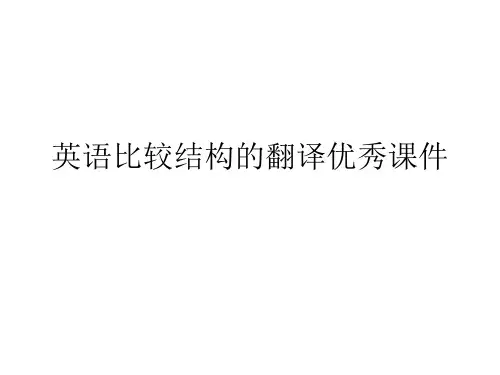
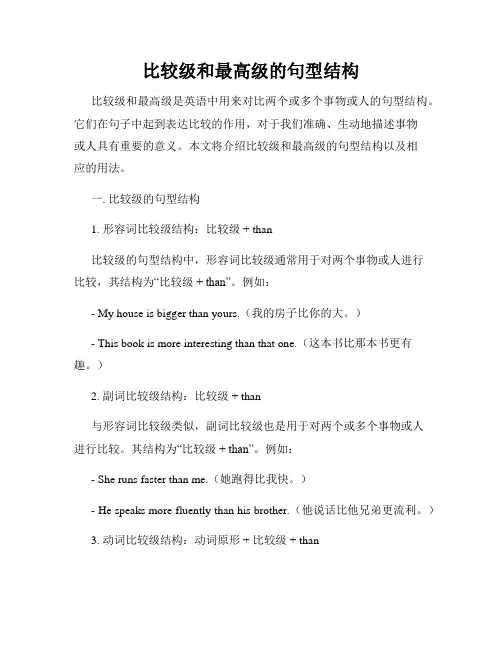
比较级和最高级的句型结构比较级和最高级是英语中用来对比两个或多个事物或人的句型结构。
它们在句子中起到表达比较的作用,对于我们准确、生动地描述事物或人具有重要的意义。
本文将介绍比较级和最高级的句型结构以及相应的用法。
一. 比较级的句型结构1. 形容词比较级结构:比较级 + than比较级的句型结构中,形容词比较级通常用于对两个事物或人进行比较,其结构为“比较级+ than”。
例如:- My house is bigger than yours.(我的房子比你的大。
)- This book is more interesting than that one.(这本书比那本书更有趣。
)2. 副词比较级结构:比较级 + than与形容词比较级类似,副词比较级也是用于对两个或多个事物或人进行比较。
其结构为“比较级+ than”。
例如:- She runs faster than me.(她跑得比我快。
)- He speaks more fluently than his brother.(他说话比他兄弟更流利。
)3. 动词比较级结构:动词原形 + 比较级 + than动词比较级结构用于比较两个或多个动作的强度、频率等。
一般的结构为“动词原形 + 比较级+ than”。
例如:- I study harder than my classmates.(我学习比我的同学更刻苦。
)- They work more efficiently than us.(他们工作比我们更高效。
)二. 最高级的句型结构最高级用于比较三个或三个以上的事物或人中的某个在某方面的特征。
以下是两种最高级的句型结构及相应的用法。
1. 形容词最高级结构:the + 形容词最高级 + 名词 + in/of形容词最高级结构用于表示某个事物或人在某一方面具有最高程度的特征。
一般的结构为“the + 形容词最高级 + 名词+ in/of”。
例如:- She is the tallest girl in the class.(她是班里最高的女孩。
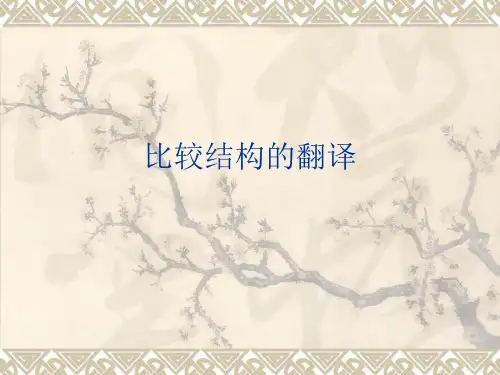
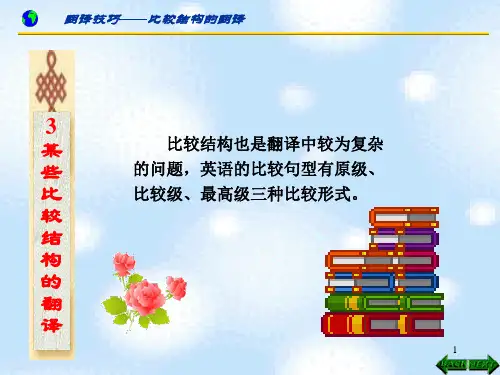
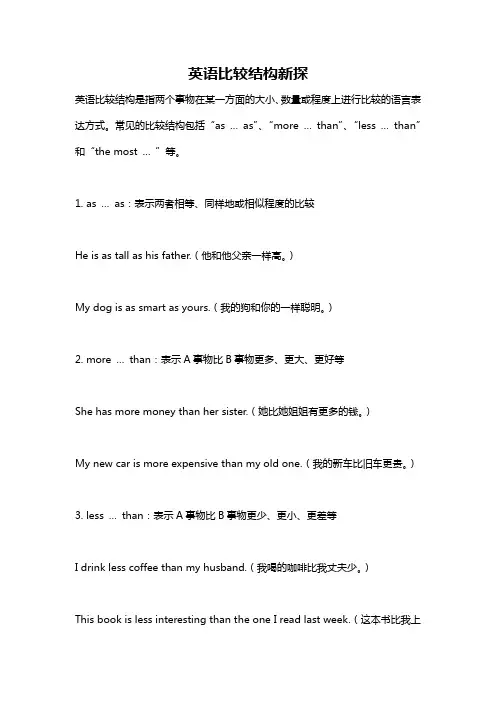
英语比较结构新探英语比较结构是指两个事物在某一方面的大小、数量或程度上进行比较的语言表达方式。
常见的比较结构包括“as …as”、“more …than”、“less …than”和“the most …”等。
1. as …as:表示两者相等、同样地或相似程度的比较He is as tall as his father.(他和他父亲一样高。
)My dog is as smart as yours.(我的狗和你的一样聪明。
)2. more …than:表示A事物比B事物更多、更大、更好等She has more money than her sister.(她比她姐姐有更多的钱。
)My new car is more expensive than my old one.(我的新车比旧车更贵。
)3. less …than:表示A事物比B事物更少、更小、更差等I drink less coffee than my husband.(我喝的咖啡比我丈夫少。
)This book is less interesting than the one I read last week.(这本书比我上周读的那本书不那么有趣。
)4. the most …:表示A事物在某一方面比其他所有事物都更多、更好等She is the most beautiful girl in the class.(她是班上最漂亮的女孩。
)This is the most difficult exam I have ever taken.(这是我考过的最难的考试。
)总的来说,英语比较结构的使用是一种很常见的表达方式,我们可以通过使用不同的比较结构,来表达对事物的大小、数量或程度的不同程度的比较。
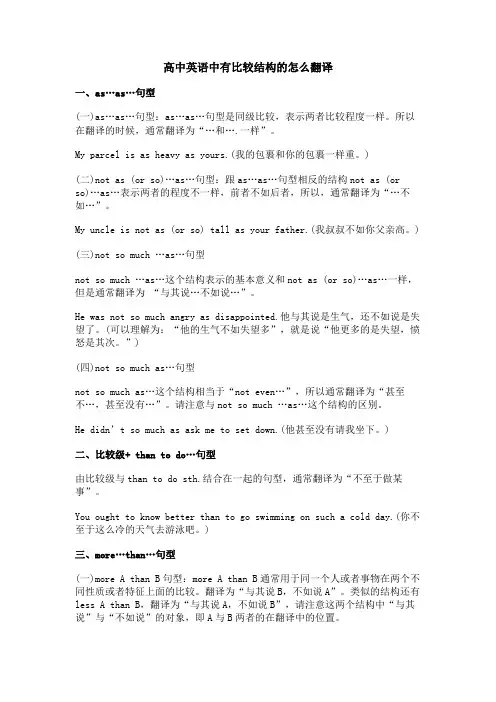
高中英语中有比较结构的怎么翻译一、as…as…句型(一)as…as…句型:as…as…句型是同级比较,表示两者比较程度一样。
所以在翻译的时候,通常翻译为“…和….一样”。
My parcel is as heavy as yours.(我的包裹和你的包裹一样重。
)(二)not as (or so)…as…句型:跟as…as…句型相反的结构not as (or so)…as…表示两者的程度不一样,前者不如后者,所以,通常翻译为“…不如…”。
My uncle is not as (or so) tall as your father.(我叔叔不如你父亲高。
)(三)not so much …as…句型not so much …as…这个结构表示的基本意义和not as (or so)…as…一样,但是通常翻译为“与其说…不如说…”。
He was not so much angry as disappointed.他与其说是生气,还不如说是失望了。
(可以理解为:“他的生气不如失望多”,就是说“他更多的是失望,愤怒是其次。
”)(四)not so much as…句型not so much as…这个结构相当于“not even…”,所以通常翻译为“甚至不…,甚至没有…”。
请注意与not so much …as…这个结构的区别。
He didn’t so much as ask me to set down.(他甚至没有请我坐下。
)二、比较级+ than to do…句型由比较级与than to do sth.结合在一起的句型,通常翻译为“不至于做某事”。
You ought to know better than to go swimming on such a cold day.(你不至于这么冷的天气去游泳吧。
)三、more…than…句型(一)more A than B句型:more A than B通常用于同一个人或者事物在两个不同性质或者特征上面的比较。
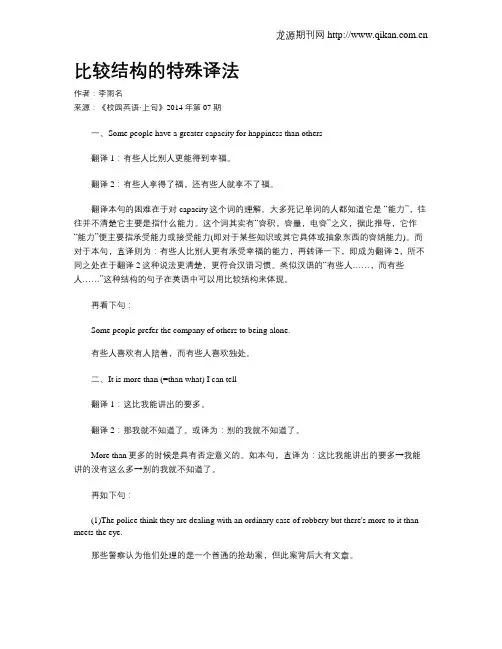
比较结构的特殊译法作者:李雨名来源:《校园英语·上旬》2014年第07期一、Some people have a greater capacity for happiness than others翻译1:有些人比别人更能得到幸福。
翻译2:有些人享得了福,还有些人就享不了福。
翻译本句的困难在于对capacity这个词的理解。
大多死记单词的人都知道它是“能力”,往往并不清楚它主要是指什么能力。
这个词其实有“容积,容量,电容”之义,据此推导,它作“能力”便主要指承受能力或接受能力(即对于某些知识或其它具体或抽象东西的容纳能力)。
而对于本句,直译则为:有些人比别人更有承受幸福的能力,再转译一下,即成为翻译2,所不同之处在于翻译2这种说法更清楚,更符合汉语习惯。
类似汉语的“有些人……,而有些人……”这种结构的句子在英语中可以用比较结构来体现。
再看下句:Some people prefer the company of others to being alone.有些人喜欢有人陪着,而有些人喜欢独处。
二、It is more than (=than what) I can tell翻译1:这比我能讲出的要多。
翻译2:那我就不知道了。
或译为:别的我就不知道了。
More than更多的时候是具有否定意义的。
如本句,直译为:这比我能讲出的要多→我能讲的没有这么多→别的我就不知道了。
再如下句:(1)The police think they are dealing with an ordinary case of robbery but there's more to it than meets the eye.那些警察认为他们处理的是一个普通的抢劫案,但此案背后大有文章。
There's more than meets the eye直译:有比眼睛(看到的)更多(的东西→有些你是从表面看不到的→不只是象表面看到的那么简单→背后大有文章。
表示比较的英语表达
在英语中,表示比较的表达有很多种,取决于所要比较的对象和程度。
以下是一些常见的比较表达:
形容词和副词的比较级:
比较级通常在形容词或副词前面加上"-er" 或者在前面加"more" 来表示比较,比如"bigger"(更大的), "more beautiful"(更漂亮的)。
名词的比较:
使用"more" 或"less" 来表示数量或程度的比较,比如"more apples"(更多的苹果), "less time"(更少的时间)。
"than" 的使用:
在比较句中,通常会使用"than" 来引导被比较的对象,比如"She is taller than her sister"(她比她妹妹高)。
"as... as" 结构:
表示两者一样时,可以使用"as... as" 结构,比如"as tall as"(和...一样高), "as smart as"(和...一样聪明)。
最高级:
在比较中表示最高程度时,通常在形容词或副词前加上"-est" 或者在前面加"most",比如"the biggest"(最大的), "the most beautiful"(最漂亮的)。
当涉及到比较级和最高级时,需要注意形容词和副词的变化规则,以及不规则的变化形式。
英语“比较结构”的含义英语中有许多less than,more than,as much as,形似比较结构的短语,但并没有比较的意思。
对这种结构的意思应根据词典和上下文来辨认,不能想当然。
1. less…thanHitler’s mistakes gave Roosevelt the victory; just as at Waterloo it was less Wellington who won than Napoleon who lost.当less…than后面的成分相同时,这个结构并没有比较意义,而是“与其说……不如说是”希特勒犯下的错误使罗斯福取得了胜利;正如在滑铁卢战场上,与其说是威灵顿打胜了,不如说是拿破仑战败了。
It was a curious exchange, less a debate than a quarrel between two aggressive men.这是一次奇妙的交锋,与其说是两个好斗的人之间的一场辩论,不如说是一次吵嘴。
比较:Even the dullest work is to most people less painful than idleness. less…than后面的成分不同,可以译成比较结构。
对大多数人来说,再单调乏味的工作也要比无所事事好受。
2. no less + adj. (than)Those higher up on the social ladder are no less anxious. Their lives are no less empty than those of their subordinates.no less (…than) 的结构没有比较的意思,作为一个固定词语,它的意思是“同样”。
那些社会地位高的人同样感到焦虑。
他们的生活如同他们手下人的生活一样空虚。
As regards our foreign policy, it is no less our interest than our duty to maintain the most friendly relations with other countries.关于我们的对外政策,维持和其他国家的友好关系,既是我们的义务,也同样是我们的利益。
英语翻译技巧:比较结构关于英语翻译,不同的人有不同的方法,但是在面对同样的题型的时候,你知道该怎样有效的进行下去吗?下面就和大家分享英语翻译技巧:比较结构,希望能够帮助到大家,来欣赏一下吧。
英语翻译技巧:比较结构从理解与表达的角度来看,比较的形式是次要的,真正重要的是意义上的比较。
只要意义上表示比较,就属于比较句式。
常见的比较结构的意义很容易理解,所以也比较容易翻译,如:I am taller than he.(我比他高)。
因此,这里不再叙述基本比较结构的翻译方法,而主要介绍在意义上容易混淆的比较结构的翻译。
一、as…as…句型(一)as…as…句型as…as…句型是同级比较,表示两者比较程度一样。
所以在翻译的时候,通常翻译为“…和….一样”。
My parcel is as heavy as yours.我的包裹和你的包裹一样重。
She is as much interested in music as ever.她和以前一样对音乐感兴趣。
The economic development in our country is as stable recently as formerly.近,我国的经济发展和以前一样稳定。
(二)not as (or so)…as…句型跟as…as…句型相反的结构not as (or so)…as…表示两者的程度不一样,前者不如后者,所以,通常翻译为“…不如…”。
My uncle is not as (or so) tall as your father.我叔叔不如你父亲高。
People are not so honest as they once were.人们现在不如过去那样诚实了。
(三)not so much …as…句型not so much …as…这个结构表示的基本意义和not as (or so)…as…一样,但是通常翻译为“与其说…不如说…”。
He was not so much angry as disappointed.他与其说是生气,还不如说是失望了。
英汉句法结构对比与翻译
1.主谓结构:英语中主语和谓语动词之间的位置固定,而且一般不允许有其他成分插入;汉语中则允许主谓之间插入状语、宾语等成分,主语通常出现在句首,谓语动词出现在句尾。
英语:He is reading a book.
汉语:他正在看书。
2.宾语结构:英语中宾语通常出现在动词后面,而且一般不允许有其他成分插入;汉语中宾语可以放在动词前面或后面,并且可以有其他成分插入。
英语:She likes to eat apples.
汉语:她喜欢吃苹果。
3.状语结构:英语中状语通常出现在动词后面,表示时间、地点、方式等信息;汉语中状语的位置比较灵活,可以出现在句首、句中或句尾。
英语:He goes to school by bus every day.
汉语:他每天坐公交车去学校。
在进行翻译时,需要根据英语和汉语的句子结构差异进行相应的调整和转换。
具体翻译方法有:
1.主谓结构的翻译:将英语的主语翻译为汉语的主语,谓语动词翻译为汉语的谓语动词。
2.宾语结构的翻译:将英语中的宾语翻译为汉语中的宾语,并根据需要放置在动词前面或后面。
3.状语结构的翻译:将英语中的状语翻译为汉语中的状语,并根据需要放置在句首、句中或句尾。
需要注意的是,不仅要考虑句子结构的差异,还要考虑语言的习惯表达方式和上下文的语境。
对于复杂的句子结构和长篇文章的翻译,还需要进行更加细致的分析和翻译。
比较结构的翻译英语中比较结构的使用频率比汉语高,对比较结构一要正确理解,二要根据汉语表达需要,灵活变通,不要一概呆板地译为“比…更…”之类的字眼。
1.I had gone away to college by now, and resettled in California. I kept in touch through my sister, but I was too busy working and eagerly seeking out all the magic things Hazel’s books had told me about to give much more than a fleeting thought to Milltown.那时我已去上大学, 在加州定居。
我通过姐姐和家乡保持联系,但我学习太忙,在急切地探索黑兹尔那些书告诉过我的所有的奇妙的事情,只是有时才想起米尔镇。
2.When he (son of Rawdon) was gone, he (Rawdon) felt more sad and downcast than he cared to own…far sadder than the boy himself, who was happy enough to enter a new career, and find companions of his own age.他走了以后,罗登闷闷不乐,然而心里的烦恼又不愿对人说。
小罗登不比父亲,他到了一个新的环境,还有年龄相仿的同伴,倒很快乐。
3.Americans carry with them an appearance which is more a result of attitude than of clothing.美国人所呈现出的外表,与其说是衣着所致还不如说是观念所致。
4.Hitler’s mistakes gave Roosevelt the victory; just as at Waterloo it was less Wellington who won than Napoleon who lost.希特勒犯下的错误使罗斯福取得了胜利;正如在滑铁卢战场上,与其说惠灵顿打胜了,不如说是拿破仑战败了。
作者: 江文国
作者机构: 浙江商业职业技术学院,浙江杭州310057
出版物刊名: 语文学刊:高等教育版
页码: 87-88页
年卷期: 2011年 第12期
主题词: 比较结构;短语;翻译
摘要:比较结构形式的短语在英语使用极其广泛。
常用的比较结构形式的短语包括more…than…,less…than…,not so much…as…,the least…,这些短语的语义其实非常的丰富,理解起来并非易事。
初学翻译的人在翻译这些结构时,往往容易理解成字面的意思,翻译出来的句子常常显得晦涩难懂。
本文重点讨论了这些结构的常用翻译方法。